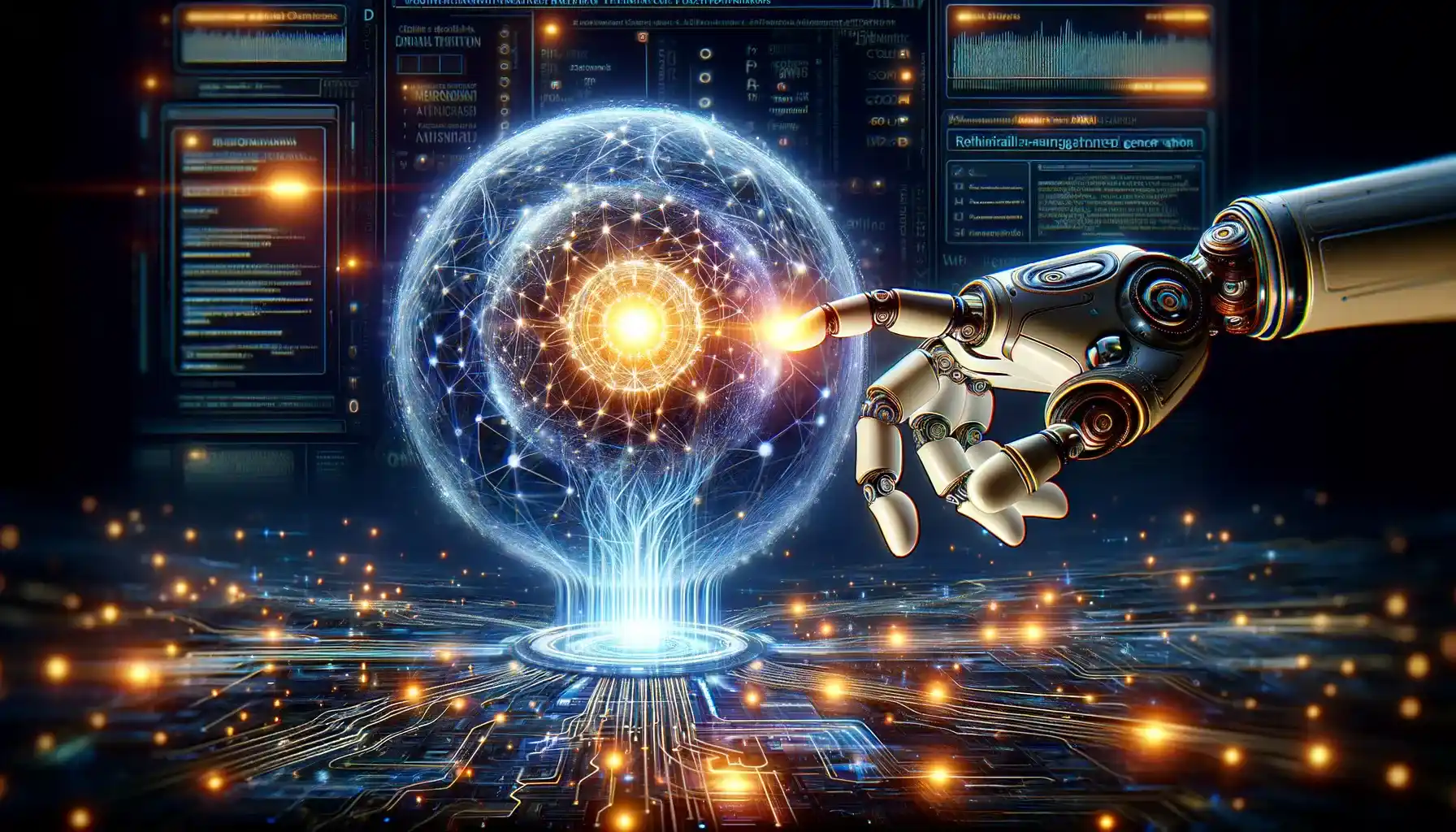Table of Contents
Large Language Models (LLMs) have revolutionized natural language processing, enabling machines to comprehend and generate human-like text. However, to truly harness their power, it’s essential to optimize LLMs using advanced techniques like Retrieve and Generate (RAG). In this article, we’ll explore the significance of optimizing LLMs with RAG techniques and explore real-time illustrations illustrating their effectiveness.
Understanding LLMs with RAG
Large Language Models (LLMs), such as GPT-3, excel in generating human-like text through their vast training data. However, their performance can be significantly enhanced by integrating retrieval-based methods with generative approaches, as demonstrated by the RAG framework. RAG leverages pre-trained LLMs as generators while incorporating a retrieval mechanism to select and incorporate relevant information from a knowledge source.

This integration not only improves the coherence and relevance of generated text but also enables the model to access a broader range of information beyond its pre-training data, making it more versatile and effective in various tasks such as question answering, text summarization, and content generation. By combining the strengths of LLMs and retrieval-based methods, RAG represents a powerful advancement in natural language processing, enabling more sophisticated and contextually rich text generation.
Leveraging Retrieval in LLMs
Incorporating RAG techniques into LLMs revolutionizes their capabilities by enabling them to access and utilize vast repositories of knowledge effectively. By integrating retrieval mechanisms, such as fetching relevant passages from extensive text corpora, LLMs can swiftly comprehend the context and generate responses that are not only contextually accurate but also highly informative.
For instance, envision a customer support chatbot for a software product empowered with RAG techniques. When confronted with user inquiries, this chatbot seamlessly retrieves precise troubleshooting steps from its knowledge base, ensuring that users receive tailored and actionable assistance promptly.
By harnessing the power of retrieval-augmented generation, LLMs transcend mere language processing to become dynamic information hubs, effortlessly tapping into rich reservoirs of data to deliver precise and helpful responses.
This integration empowers chatbots and similar AI systems to enhance user experiences by providing timely and relevant information. In the realm of customer support, for instance, LLMs equipped with RAG techniques enable chatbots to navigate complex queries with ease, drawing upon a wealth of knowledge to furnish users with solutions that are not only accurate but also comprehensive.
Thus, the fusion of retrieval mechanisms with LLMs represents a significant leap forward in AI-driven communication and problem-solving, promising more effective and efficient interactions between users and intelligent systems.
Enhancing Generative Capabilities
LLMs with RAG techniques not only excel in retrieving pertinent information but also shine in enhancing their generative capabilities. This entails fine-tuning the model to craft coherent and contextually relevant responses based on the retrieved data. For instance, envision a scenario where a virtual assistant is entrusted with composing emails for users.
Leveraging RAG techniques, the assistant adeptly retrieves pertinent details from past email exchanges and harnesses this information to craft personalized responses that resonate with the user’s communication style and preferences.
By seamlessly blending retrieval and generation capabilities, LLMs with RAG empower virtual assistants to deliver tailored and insightful communications, enhancing user experience and productivity.

Real-Time Illustrations of RAG in Action
1. Search Engine Enhancement
Search engines such as Google employ RAG techniques to enhance the accuracy and relevance of search results. RAG combines retrieval-based methods, which fetch relevant web pages based on user queries, with generative algorithms that generate contextually relevant content. This integration enables search engines to not only retrieve pages matching the user’s query but also generate supplementary content that better fits the user’s context, resulting in a more precise and satisfactory search experience.
By leveraging LLMs within the RAG framework, search engines can effectively understand user intent, retrieve pertinent information, and generate additional content to deliver more tailored and informative search results. This advancement marks a significant step forward in improving search engine capabilities and meeting the evolving needs of users in accessing relevant online information.
2. Content Recommendation Systems
Content recommendation systems, such as those utilized by streaming platforms like Netflix, rely on advanced techniques like RAG to enhance user experiences. With RAG, these systems retrieve relevant information about users’ viewing history and preferences, enabling them to generate personalized recommendations.
By analyzing data on what users have watched and enjoyed in the past, RAG algorithms can intelligently suggest content that aligns with individual tastes and interests. This personalized approach not only increases user satisfaction but also fosters engagement and retention on the platform.
Utilizing LLMs with RAG techniques enhances content recommendation systems by tailoring suggestions to individual user preferences and viewing habits. By leveraging retrieval mechanisms, these systems gather insights into user behavior to generate captivating content recommendations. This targeted approach improves the user experience, increasing retention and loyalty for both users and streaming platforms.
3. Medical Diagnosis Assistance
In the ever-evolving landscape of healthcare, LLMs with RAG techniques are revolutionizing medical diagnosis. Through the retrieval of pertinent patient data from electronic health records and comprehensive medical literature, LLMs efficiently generate diagnostic insights. These insights serve as invaluable aids to healthcare professionals, empowering them with well-informed decision-making capabilities.
By amalgamating cutting-edge technology with vast repositories of medical knowledge, LLMs with RAG capabilities are poised to significantly enhance diagnostic accuracy and patient care outcomes.

Implementing RAG for LLM Optimization
To optimize LLMs with RAG techniques, several steps can be taken:
- Data Preprocessing: To prepare external knowledge sources for compatibility with the input format of LLMs such as RAG several steps are necessary. Firstly, the data needs to be formatted into a structured or semi-structured format, such as JSON or CSV, to facilitate easy parsing and integration with the model. Additionally, any text within the knowledge sources should be preprocessed to remove noise, standardize language, and ensure uniformity. This preprocessing might involve tasks such as tokenization, stemming, and entity recognition. Furthermore, depending on the specific requirements of the LLM, additional metadata such as timestamps or relevance scores may need to be included. By preparing the external knowledge sources in this manner, they can be effectively leveraged by LLMs like RAG to enhance natural language understanding and generation tasks.
- Training Integration:
Incorporating RAG methods during the training phase of Large Language Models involves seamlessly integrating retrieval and generation processes. This approach enhances the LLM’s capabilities by enabling it to retrieve relevant information from external knowledge sources during generation tasks, thereby enriching its output with contextually accurate and diverse content. By training LLMs with RAG methods, they can leverage the vast array of information available online, improving their performance in tasks requiring comprehensive understanding and nuanced responses. - Fine-Tuning: Fine-tuning involves the process of optimizing a LLM such as OpenAI’s GPT, using RAG-specific datasets to enhance its capacity for retrieving and effectively utilizing external information. RAG is a framework that combines retrieval-based and generation-based approaches to enhance the model’s understanding and generation capabilities by incorporating information retrieval from external sources. By fine-tuning the LLMs with RAG-specific datasets, the model can better leverage external knowledge sources, resulting in more accurate and contextually relevant outputs.
Conclusion
Mastering language models involves exploring innovative techniques like RAG to enhance their performance and capabilities. By leveraging the synergy between retrieval and generation processes, LLMs with RAG techniques can surpass traditional models in various tasks, from question answering to content creation. As the field continues to evolve, the integration of RAG promises to redefine the landscape of language understanding and generation.
In conclusion, mastering LLMs with RAG techniques is not just about optimizing existing capabilities but also unlocking new possibilities for AI-driven applications in diverse domains. As researchers and developers continue to refine these techniques, we can expect LLMs with RAG to play an increasingly integral role in shaping the future of natural language processing and artificial intelligence.
FAQs
What is rag with LLMs?
Retrieval Augmented Generation is an architectural approach that enhances the performance of Large Language Models by incorporating custom data retrieval. By retrieving relevant documents or data for a given question or task, RAG provides contextual information to the LLM, thereby improving its efficacy and enabling more accurate responses.
What are the advantages of rag LLM?
The advantages of LLMs with RAG lie in their ability to transcend the limitations of parametric memory. By incorporating real-time data access, RAG enhances contextualization and enables up-to-date responses. This approach fosters accuracy, context awareness, and transparency in AI-generated content, as it facilitates source citation and minimizes data leakage.





